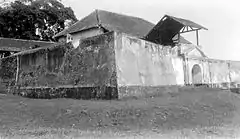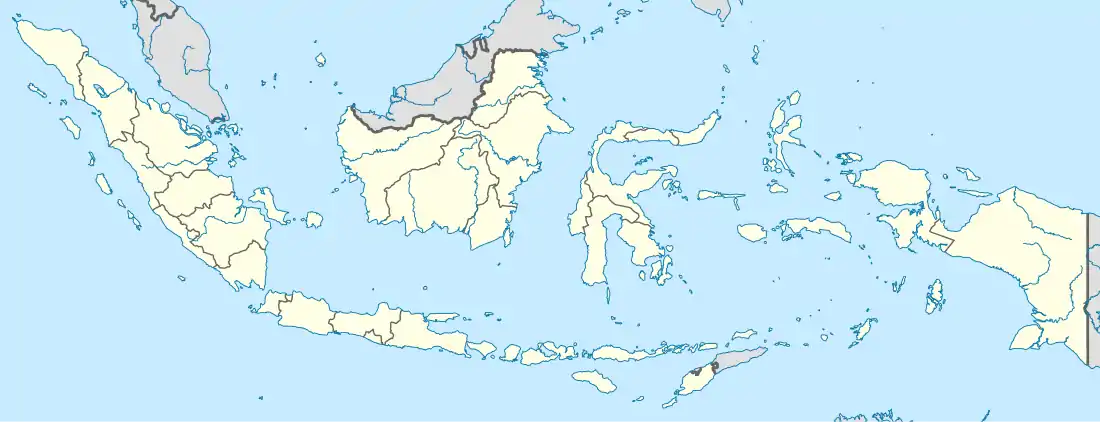Fort Willem II, Ungaran
Fort Willem II of Ungaran (known locally as Benteng Ungaran or Benteng Diponegoro) is a late 18th-century Dutch-built fort located in Ungaran, in the Semarang Regency, Central Java, Indonesia. It was constructed to guard a trade route in central Java. The fort is the place where Prince Diponegoro was imprisoned while waiting for his judgment in Batavia and further exile to Makassar. The fort is currently used as a dormitory for the families of Indonesian police personnel.
| Fort Willem II | |
|---|---|
 Fort Willem II in 1933 | |
 Location within Indonesia | |
| General information | |
| Architectural style | 18th century colonial |
| Town or city | Ungaran |
| Country | Indonesia |
| Coordinates | 7°8′17″S 110°24′18″E |
| Construction started | 1786 |
| Technical details | |
| Structural system | Stone built barracks fort |
Description
Fort Willem II is a small square-shaped fort with four bastions, located in the center of Ungaran, on the Semarang-Surakarta road. The building of the Regional People's Representative Assembly (DPRD) is located just in front of the fort. A moat used to surround the fort until the 19th century, when it was filled in. A one meter thick wall surrounds the fort. A two-floored building provide a vantage point at the western main entrance point and the eastern back entrance point. The buildings inside the fort surround an inner courtyard.[1]
History
Fort Willem II is among the Dutch oldest fortress in Java built during colonial era. There are differing opinions regarding the fort's completion. The fort was built by the Dutch in 1786 to maintain peace along a trade route in Central Java as one of the series of Dutch forts which include Fort Herstelling in Salatiga and Fort Veldwachter in Boyolali.[2] The fort was originally named Fort de Ontmoeting ("the meeting") to commemorate the historic meeting between Pakubuwono II, the first Susuhunan (ruler) of Surakarta, and Gustaaf van Imhoff, Governor-General of the Dutch East Indies, on May 11, 1746, at which the transfer of the capital of the Mataram Sultanate from Kartosuro to Surakarta was agreed. Some sources claim that the fort was built in 1712.[3] Others that the fort was constructed between 1740 and 1742 during a chaotic period in Java; with Baron van Imhoff being hospitalized in the fort after an attack by a force from Surakarta in 1742.[3]
Between 1800 and 1807 Fort Willem II was controlled by the Batavian Republic; from 1807 until 1811 French soldiers took over the fort. The British army occupied the fort from 1811 until 1816, when it was handed back to the Dutch.[4]
In 1826, during the Java War, the fort was attacked from the direction of Rembang by troops of Prince Diponegoro, led by Kyai Mojo, Diponegoro's religious advisor and military commander. The fort almost fell to Kyai Mojo after being surrounded for two weeks, but it held out until Kyai Mojo withdrew. When the war ended in 1830, Diponegoro was captured and imprisoned inside Fort Willem II for three days in August 1830 before being transferred to Batavia to be tried.[3]
In 1849, the fort was captured by the British without resistance. The British used the fort into a hospital, until it was returned to the Dutch.[1] The Dutch used the fort as a military camp between 1918 and 1919.[4]
During the Japanese occupation period of 1942 to 1945, the fort was used as prison.[4][1] It was reoccupied by the Dutch in 1945 and used as a police barracks until 1950.[4] In 1951, after Indonesian independence, it was briefly used by the Indonesian National Armed Forces before it is transferred to the police to be used as dormitory.[4] In 2007, the Semarang Regency decided to convert the fort into a museum, and in 2011 the it was renovated in preparation for the conversion. However, land ownership disputes caused problems and the restoration was cancelled.[1] The fort is currently used as a dormitory for the families of 16 members of the police department.[1]
References
- Bambang Isti 2010.
- Budiharjo 1997, p. 63.
- Javasun3 2010.
- HBR 2014.
Works cited
- Bambang Isti (June 11, 2010). "Masih Asli, Ruang Sholat Diponegoro" [Still original, the place used by Prince Diponegoro for praying]. Suara Merdeka (in Indonesian). Jakarta. Archived from the original on November 23, 2015. Retrieved November 23, 2015.CS1 maint: ref=harv (link)
- "Benteng Williem II / Benteng Ungaran". Javasun3 (in Indonesian). Wordpress. 2010. Archived from the original on 2015-11-23. Retrieved November 23, 2015.
- Budiharjo, Eko (1997). Preservation and conservation of cultural heritage in Indonesia. Yogyakarta: Gadjah Mada University Press. ISBN 9789794204269.CS1 maint: ref=harv (link)
- HBR (December 2014). "Sejarah Benteng Willem II" [History of Fort Willem II]. Serasi Media (in Indonesian). Ungaran. Archived from the original on November 23, 2015. Retrieved November 23, 2015.CS1 maint: ref=harv (link)
| Wikimedia Commons has media related to Fort Willem II. |